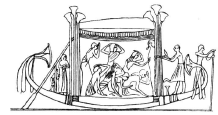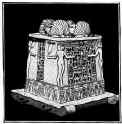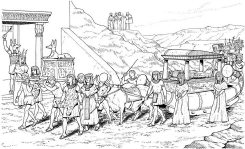

Funeral Processions in Ancient Egypt
The massive wooden boat came to rest along the bank of the Nile River. Its sacred cargo was unloaded, then placed on an ornate oxen-pulled sled. The solemn funeral procession through the valley began. Wailing cries from mourners at the head of the column filled the air as the pharaoh’s mummy was taken to its final resting place.
Funeral Boats
The Funeral Procession
How Do We Know That?
The tomb of a pharaoh or other royalty was sometimes in a remote location, so the body would have to be transported by boat and then by sled. All of the things that were to be placed in the tomb had to be carried there as well.
Funeral Boats
Around 2500 BC, ancient Egyptian craftsmen began making large boats out of cedar
wood. These boats were used for
different religious ceremonies and also for funerals.
A mummiform coffin would be loaded onto one of these boats and taken to
the location of the tomb. The funeral boats, shaped somewhat like barges, could be over
100 feet long and weigh as much as 45 tons.
To navigate the Nile in one of these boats required 12 oarsmen, six on
each side.
These boats were used for
different religious ceremonies and also for funerals.
A mummiform coffin would be loaded onto one of these boats and taken to
the location of the tomb. The funeral boats, shaped somewhat like barges, could be over
100 feet long and weigh as much as 45 tons.
To navigate the Nile in one of these boats required 12 oarsmen, six on
each side.
When a pharaoh was buried, ancient
Egyptians believed he would need a boat in the Afterlife, so they buried at
least one funeral boat near the tomb.
Top of Page
The Funeral Procession
It was tradition for ancient Egyptians to form a long procession as they made
their way to a burial site. Many people walked in the funeral procession.
At the front were mourners, usually women, who were paid to cry loudly
and sob while covering their heads with dust.
Behind the mourners came the family of the deceased and various
officials.
 The decorated sled bearing the coffin
followed next. It was pulled by two
oxen. Priests walked alongside the
sled, burning incense and sprinkling water to purify the path as the procession
moved forward. Not far behind, a
group of men carried the canopic chest containing the four jars. Servants carrying food and the deceased’s possessions
walked at the end of the column.
The decorated sled bearing the coffin
followed next. It was pulled by two
oxen. Priests walked alongside the
sled, burning incense and sprinkling water to purify the path as the procession
moved forward. Not far behind, a
group of men carried the canopic chest containing the four jars. Servants carrying food and the deceased’s possessions
walked at the end of the column.
The burial rites continued when the
procession reached the tomb. Prayers
were recited as the coffin and all of the deceased’s possessions and supplies
were placed inside the burial chamber.
Top of Page
How Do We Know That?
The most famous funeral boat is that of King Khufu.
When archaeologists discovered the boat in a pit next to the Great
Pyramid at Giza, it was in more than 100 pieces.
The boat was excavated and reassembled.
King Khufu’s boat is over 130 feet long.
It is on display at the Giza Museum.
Top of Page
Some images on this page are © 2000-2001 www.arttoday.com.